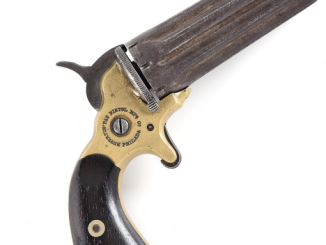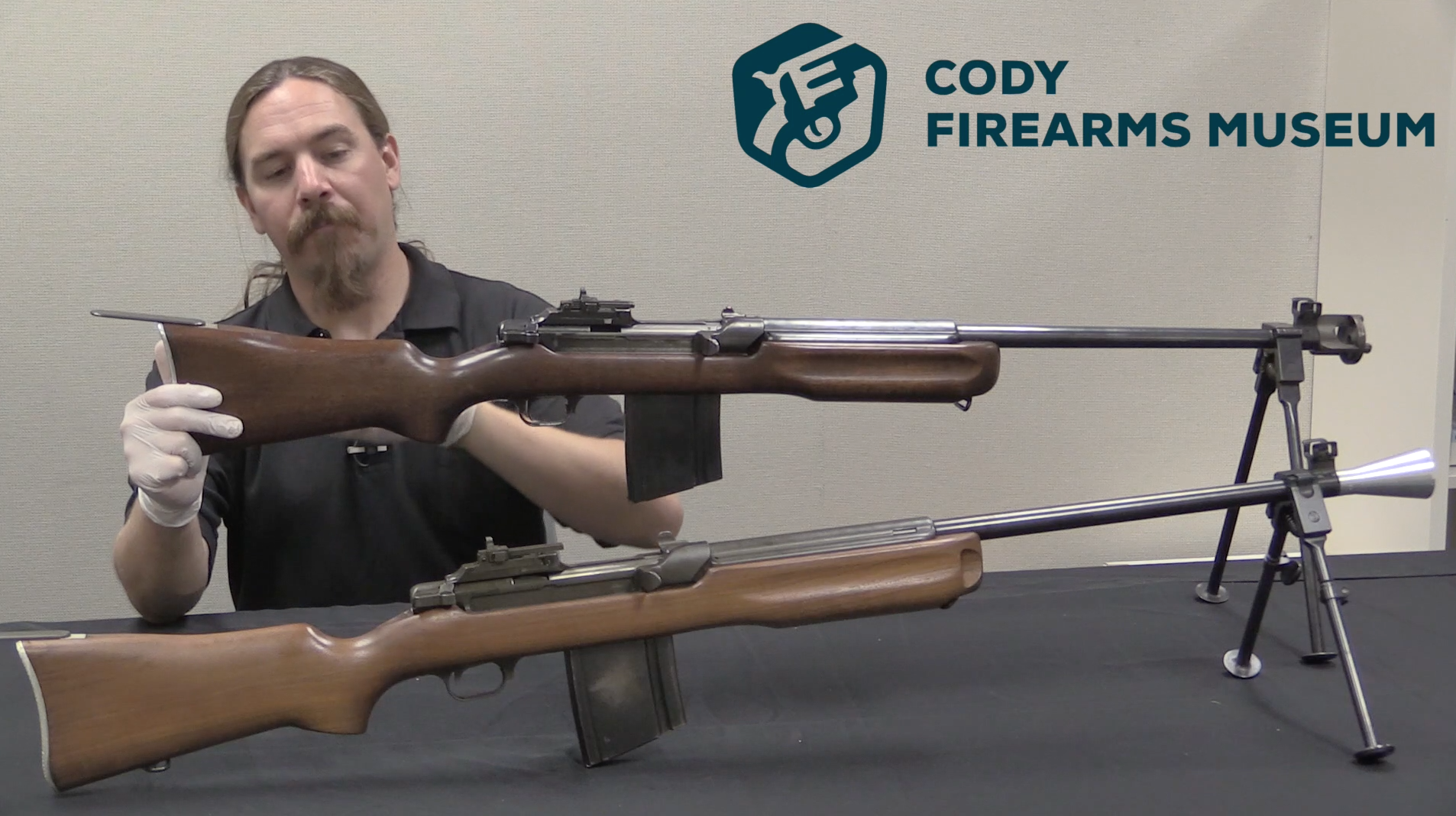The “My Friend” knuckle-duster revolver was a defensive weapon sold on the civilian market from the late 1860s until the early 1880s. It functioned both as a revolver (this one is in .22 caliber, with a 7-shot capacity) and a blunt weapon for striking. These were made in upstate New York (in the Catskills, specifically) by a man named James Reid and his company.
Related Articles

Semiauto Rifles
Johnson M1941 Video
Melvin Johnson was a gun designer who felt that the M1 Garand rifle had several significant flaws – so he developed his own semiauto .30-06 rifle to supplement the M1. His thought was that if […]

Antiques
Rupertus Pepperbox: A Sophisticated 8-Shot Rimfire Pocket Gun
The Rupertus Patent Pistol Manufacturing Company was founded in Philadelphia by Bavarian-born Jacob Rupertus. The company made a variety of derringers, pepperboxes, and revolvers and today we are looking at an 8-shot, .22 rimfire pepperbox […]

carbine williams
W.A.R. – the Winchester Automatic Rifle
With the failure of the G30M and G30R to lead to any military orders (American or otherwise), the Winchester company took the advice of the Ordnance Department to scale the design up to an automatic […]

The blog post says 5-round for this demonstrated unit, perhaps a correction is needed?
Also, I guess it’s an obvious joke but this may be the original opportunity to “Say hello to my little friend…”
Oh no, now I have a mental image of Al Pacino as Scarface shooting and punching bunch of (rivaling) bad guys with that thing. Perhaps not quite as effective as 40mm grenade from an M203 GL, but much safer to use indoors…
“My Friend” – the 19-century abound in many less or more creative names given by the firearm producers, but in early 20-century producers start tend to use rather Model Number or similar manner, can anybody of you explain this change to me?
The No. 2 model is easily distinguishable not only by its greater calibers (.32 and a few .41s) but by the fact that most of them had a 2″ to 2 1/2″ barrel sticking out front. It was rifled, and was apparently added to give the pistol at least some pretense to accuracy;
http://www.aaawt.com/html/firearms/images/308-209_Reid%20Knuckleduster-3%20in_1.jpg
These Reids have a “Suicide Special” style latch for the cylinder pin at the bottom front of the frame, as seen on this brass-framed example. The barrel “got in the way” of the original threaded-thumbscrew type pin.
Reid claimed a friend of his who was a prison guard suggested the addition of the barrel to make the pistol a better impact weapon, but this is unlikely unless it were used to “spike” someone in the head with a downward blow when held in the “knuckleduster” position, rather like the “skull-crusher” pommel on the V-42 combat knife of WW2.
Reid also claimed he was “inspired” to design the “My Friend” after witnessing the Draft Riots in NYC in 1863. You can believe as much or as little of that as you please.
All My Friend revolvers (pepperboxes?) have an odd number of chambers. This is because they do not have rebounding hammers, so the only safe way to carry them fully loaded is with the hammer resting between two chambers.
The reason this is required is that the My Friend was intended to have a sliding safety under the frame which engaged the “notch” for the cylinder stop over each chamber, that was engaged by the top of the hammer at the moment of firing.
The one Ian showed apparently does not have this safety; not all Reid guns did, but most of the later production ones generally have it in residence.
The very last Reid “My Friend” model, made in 1882-83, only slightly resembled the previous two. The “ring” had shrunk to a vestigial one behind a sheath trigger, and it was made in .22 Rf only with a 2 1/2″ barrel. It was in fact a typical single-action “Suicide Special”, distinguished from the common run only by the ring and the fact that it retained the engraved, all-metal bird’s-head grip;
http://www.aaawt.com/html/firearms/images/308-207_Rare%20Reid%20Knuckleduster_1.jpg
This still puts it in the category of the “all-metal” arms, which is a distinction in itself.
cheers
eon
What? No folding bayonet? Seems like back in the day before concealed carry laws there was no end to these sort of little hide away gizmos (lemon squeezers, knuckle dusters, et al) chambered in anemic calibers when any serious minded person could easily and legally hide a colt revolver and a bowie knife under their frock coat.
Hank, I understand your argument, but how many urban stockbroker clerks and accountants NOT living in the Wild West during the late 19th Century were trained to be able to shoot a pocket revolver at a knife-swinging mugger just spitting distance away, let alone be able to afford a Colt or a Smith & Wesson and be able to quick-draw from a concealed jacket holster? And for your information, not every over-garment can hide a bowie knife effectively…
As I understand it from original sources, the main idea for folding mini-bayonets was to have a stabbing weapon once you’d used your (one to five) shot(s), and also so that if the footpad tried to grab your gun, he’d end up with sliced fingers for his trouble.
Plus, you could always use it to peel an apple, I suppose.
One fairly dumb one illustrated in Winant’s book was a single-shot with a springloaded epee’- type blade so long that it was held by a push-button catch near the bottom of the frontstrap of a fairly large single-shot pistol. The button catch held it by its point.
I really don’t see how the user could release the blade without getting the tip of his little finger slashed in the process.
My guess is the inventor never tried it “for real”.
cheers
eon
“Oh no, now I have a mental image of Al Pacino as Scarface shooting and punching bunch of (rivaling) bad guys with that thing. Perhaps not quite as effective as 40mm grenade from an M203 GL, but much safer to use indoors…”
yes, but scarface’s brain is fuuuuuull of coke 🙂
have they ever actually been used for their intended purpose successfully ?
Given the conditions in the U.S., both on the frontier and “back East” during Reconstruction, I think it’s pretty certain that somebody got capped by one of these at least once. Probably more than once.
Keep in mind how many four-shot “pepperbox”-type pocket pistols Sharps sold. Not to mention all the European-made knockoffs. Now add in all the one and two-shot Derringers.
Even if you leave out the cheap “Suicide Specials” and the more up-market “Bulldog”-type pocket revolvers, there was a large market for these “stingy guns”. I doubt that all of them spent their lives sitting quietly in dresser drawers at home.
cheers
eon
And when the era of automatic pistol begin, Colt produces a significant amount of “Model 1908 Vest Pocket” firing .25 Auto round, ballistically in same category as .22 Long Rifle. These pistols were produced until 1948 so there was need for firearm like this.
There was a market, yes. ‘Need’ is rather debatable. Having fired the things, I think a lot of folks bought one then decided on Plan B
While these little buggers may seem anemic, a .22 to the chest or the face at “card table” range, while not always instantly lethal, would definitely give an attacker pause and the victim a chance to get away (or get off a few more shots). And, if the bullet didn’t kill them, the subsequent infection probably would. IIRC it wasn’t the bullet that killed Pres. Garfield so much as the doctors’ dirty fingers probing for the projectile. We had a local case of “justifiable homicide” around here not to long ago, where an angry bar patron was waiting for his “victim” in the parking lot while armed with a baseball bat (seems there was a woman, spurned love, jealousy, etc. involved). The “victim” got out of his car and was attacked by the bat-wielding fellow, and was knocked down. As Mr. Baseball stood over his “victim,” ready to administer the final blow, the “victim” turned over, produced a .22 NAA Mini-revolver, and shot his attacker in the chest. According to the EMT, the bullet pierced the attacker’s heart, and he was dead when he hit the ground. The .22 might not be a “man-stopper,” but is definitely a “man-killer” when put in the right place.
Don’t sell the .22 short (no pun intended)in a gunfight. First off, Charles Askins and Bill Jordan both agreed that most gunfights were at an average distance of 7-8 FEET. The longest I was ever in was 63 yards and the rest at less than 15 feet. At that range I have killed deer, wild/feral hogs, large cattle and etc with .22 pistols and rifles. Until lately the Enuit (Eskimo) considered the .22 appropriate for killing polar bear and large seal plus the odd caribou at close range. A .22 Colt Woodsman is appropriate for any human at short range as has been demonstrated by the military for years, especially with a suppressor. Up until the late-1960s the most homicides every year were with the .22. It’s not as much the power as the placement that counts.
Not really a reply – just adding a point.
My only contact with .22 Long Rifle (Obviously, not on the receiving side) was with teh sporting weapons – that is the ones with soft bullet.
I was always told by the instructors (on the other hand, perhaps they always say that) not to sell short the small calibre of this bullet, because its soft head is MUSHROOMING in the body.
REgards, Andrzej
I have to honestly say i really like the design. If it were available today i would probably buy it. Doc mentioned the NAA mini revolvers; IMHO I think this gun would be easier to use with a little practice. The impact weapon component of the design certainly seems viable as well.
There was a market, yes. ‘Need’ is rather debatable. Having fired the things, I think a lot of folks bought one then decided on Plan B
Sharron Stone’s character in The Quick and the Dead carries one of these in the scene where she has a fancy dinner with Gene Hackman’s character.